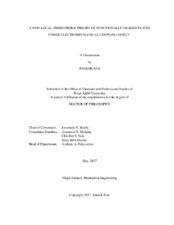| dc.description.abstract | In this research, a general nonlinear third-order plate theory has been developed using the principle of virtual displacements. The developed theory is based on geometric nonlinearity, size effects of structures in micro scale, functionally graded materials, and piezoelectric effects. The von Kármán nonlinear strains, i.e., small strain and moderate rotation, are considered to represent geometric nonlinearity. A modified couple stress theory is adopted to capture microstructure dependent size effect. A power law distribution is used to represent the variation of two material constituents through thickness. The developed plate theory is also specialized to classical, first order shear deformation, and Reddy third order plate theories.
Analytical solutions for the developed plate theory are presented using the Navier solution technique. All dependent variables are assumed to be forms of double trigonometric functions which satisfy the boundary conditions. The analytical solutions are limited to geometric linearity and simply supported plates. Examples of bending, buckling, and vibration problems are presented to show effects of the power-law distribution of two materials and the microstructure-dependent size parameter.
The nonlinear finite element model based on the developed plate theory is carried out to study of the static bending problems regarding the size effects of microstructure, geometric nonlinearity, and power-law variation of the material composition through the thickness. The principle of virtual work is utilized to develop a displacement based weak-form Galerkin finite element model which requires C^1 continuity of all dependent variables. A conforming element is implemented using Hermite type interpolation functions.
The piezoelectric effect is considered for functionally graded smart plates which have surface-mounted piezoelectric layers, and a functionally graded core layer. The formulation includes the coupling between mechanical deformations and the charge equations of electrostatics. In addition to the kinematic assumption of the developed plate theory, the potential function is assumed to be the combination of half cosine variation of electric potential and linear variation of applied voltage on outer surfaces. An analytical solution and a finite element model are obtained. A parametric study is presented to show effects of thickness ratio between core layer and piezoelectric layers in addition to material variation of core plate and micro structure size effects. | en |


